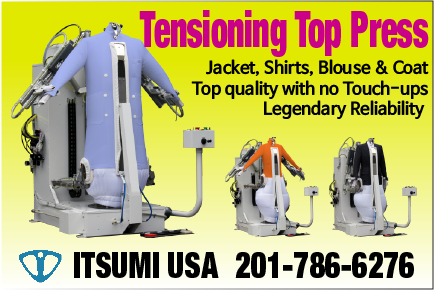I’ve been writing this column for a long time – over 15 years – and it doesn’t appear that I have ever discussed wash formulas. That is not entirely an accident. I usually give the chemical reps all the necessary latitude to program your shirt washer in order to best utilize the chemicals that they sell. However, for some reason, I have seen some quirky formulas out there lately, so I thought that I should put forth my opinion on this matter. First, let me outline the basic formula, then I’ll go into more depth.
- Break – 10 minutes
- Wash – 15 minutes
- Drain
- Rinse – 2 minutes
- Drain
- Rinse – 2 minutes
- Drain
- Rinse – 2 minutes
- Drain
- Sour – 3 minutes
- Extract – not long
Break – 10 minutes
Some people call this a pre-wash. This is the cycle during which you want to add all of your products. This can be simply an enzyme product or a combination of a built detergent, oxygen bleach and alkaline booster. Regardless, add all of the chemical in now. And put all of it directly in the drum, rather than using the dispenser compartments. In days of old, this cycle was used differently. It was cold water and used to remove blood stains. As you know, blood is a cold water stain – hot water sets blood stains – so a cold water pre-wash was useful. Blood stains on the collar were more common because men shaved with single blade straight razors and nicked themselves more regularly. These days, that particular stain is far less common. You might see one every week or every month. Cold water is still the proper course of action, but because of its infrequency, it not worth the time and expense. If you fill a drum with cold water, wetting all of the 100+ shirts and making them cold as well, all to remove that, perhaps non-existent, blood stain, you will then need a whole lot of hot water in order to make those 50 degree shirts into 130 degree shirts. I’ve never done the math on this, but, without question, it will take more energy to bring these newly chilled shirts up to temperature than if the shirts had been at ambient temperature. But what about the occasional blood stain? My belief is that a shirt stained with blood, ink or other similar stain, is a drycleaning item. It should be taken in as such, clean as such, charged as such and then finished on a shirt press. Treating them as a routine shirt will either require a considerable amount of extra work or, even worse, a disappointed customer.

Intermediate Drain
As the break cycle runs through, the detergent gets sudsy. Bubbly. These bubbles look good and give you the impression of a good cleaning, but this is a smoke screen. The bubbles are an “air-cushion” that impedes – in fact, adversely affects – good mechanical action. You must get rid of these bubbles with an intermediate drain in order to assure good cleaning.
Wash – 15 minutes
With the bubbles removed and no additional product added, you will be surprised at how much suds you still see. The Break cycle has removed the less stubborn stains and now, during this wash cycle, you will attack those that need maximum mechanical action which you will get because you have removed the bubbles and have a 15-minute time span to work at them. Failure to understand this is the most common mistake made at washing shirts. Adding chemicals doesn’t do much, but understanding and adhering to the science does it all.
The next steps are drains and high-level rinses at decreasing temperatures, ending at around 80-90 degrees. I haven’t mentioned temperatures here. I will leave that to the chemical manufacturers. But remember that if the chemical manufacturers are looking for, say, 120 degrees, you will need to set your water heater for a significantly higher temperature. The amount of temperature that the water loses is controversial. The length of pipe between the water heater and the diameter of that pipe, as well as how quickly the water flows through that pipe (water pressure) all contribute significantly to what the temperature will be at the washer, as compared to the temperature at the heat source.
Sour – 3 minutes
If you are using enzyme detergent, the alkali never gets very high so you may not use a sour. But keep in mind that you should have a pH of 5.5 to get the most out of your starch cycle (low level, 100 degrees, 8-10 minutes, by the way).

Extract
Through all of this, we have yet to extract, but we will now.
If you have a old-fashioned shirt unit – one that has a sleever press – AND you are getting 95+ shirts per hour, extract your heart out. You will get great quality and great productivity. However, if you are more typical, with a blown sleeve press, you will need to have 50% to 60% moisture retention. This is much wetter than you think and your pressers will probably comment, but your quality will improve dramatically. Do this by weight, not time. 60% moisture retention is when 100 pounds of dry weight weighs 160 pounds after extraction. This is usually accomplished by extracting for only 60 seconds.
These simple steps are the Holy Grail.
Your wash quality will improve (getting rid of those bubbles is key!)
Your press quality will improve (with wetter shirts, you will produce a better shirt, hot off the press. You’ll be amazed!)
Improved press productivity (when your shirts are dry, the pressers often spray the shirts with an atomizer. Along with management help, you can get them to break this habit resulting in increased shirts-per-hour.
You will save labor (less touch-up + better productivity = lower cost)
“If you do what you’ve always done, you’ll get what you always got.”

Donald Desrosiers
Don Desrosiers has been in the laundry and drycleaning industry for over 30 years. As a management consultant, work-flow systems engineer and efficiency expert, he has created the highly acclaimed Tailwind Shirt System, the Tailwind System for Drycleaning and Firestorm for Restoration. He owns and operates Tailwind Systems, a management consulting and work-flow engineering firm. Desrosiers is a monthly columnist for The National Clothesline, Korean Cleaners Monthly, The Golomb Group Newsletter and Australia's The National Drycleaner and Launderer. He is the 2001 winner of IFI's Commitment to Professionalism Award. He has a website at www.tailwindsystems.com and can be reached at tailwindsystems@charter.net or my telephone at 508.965.3163
